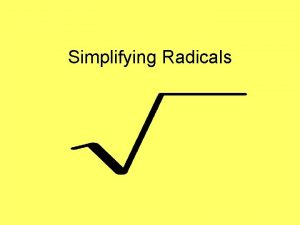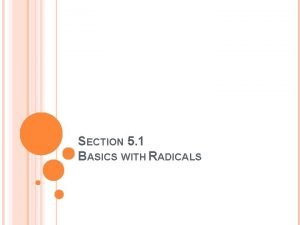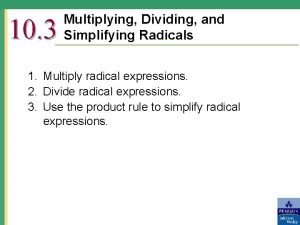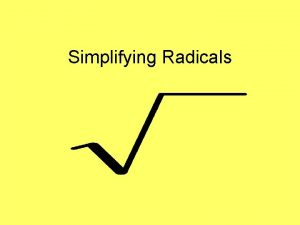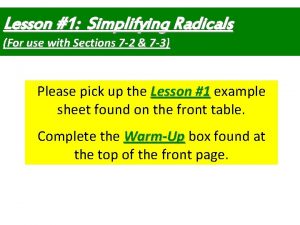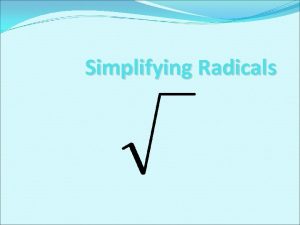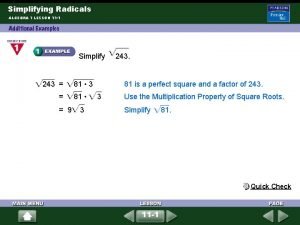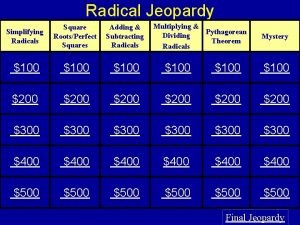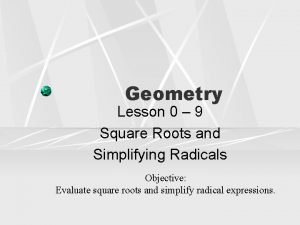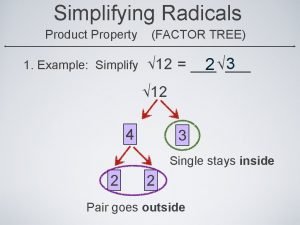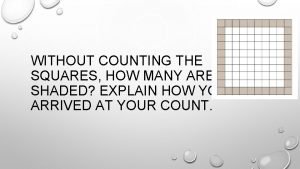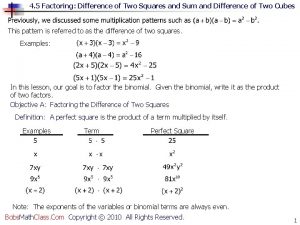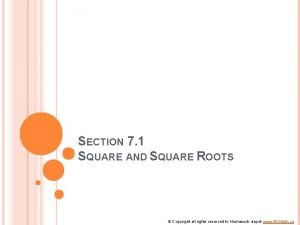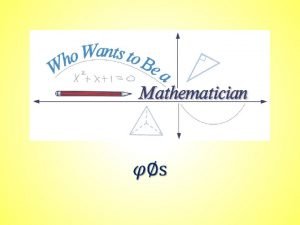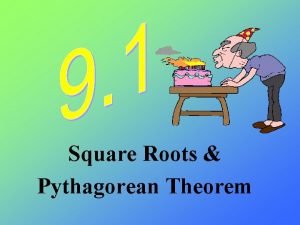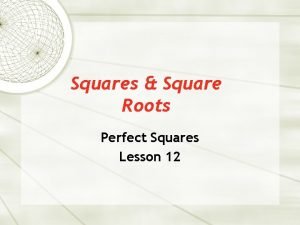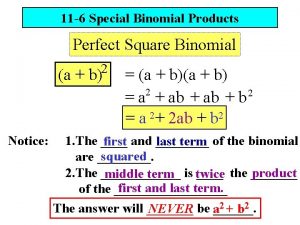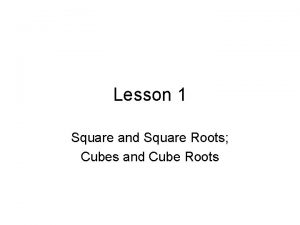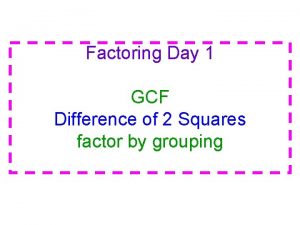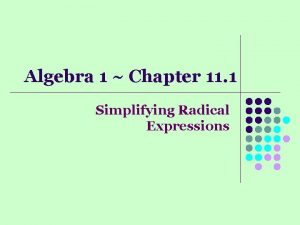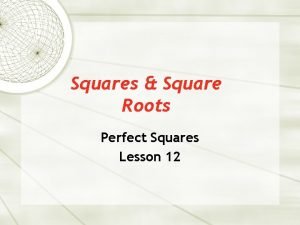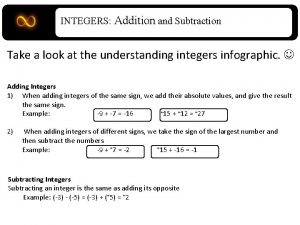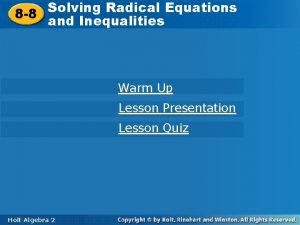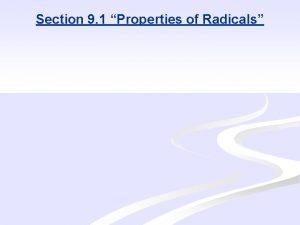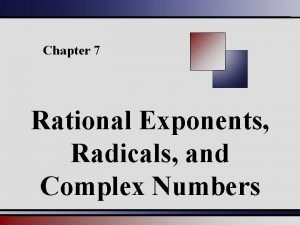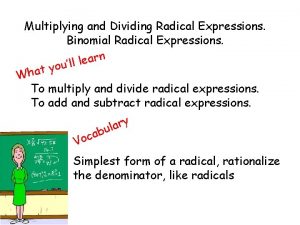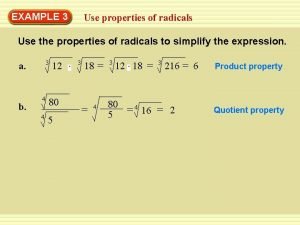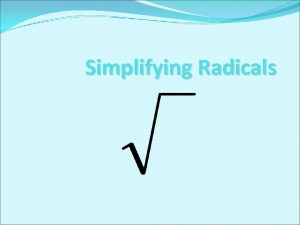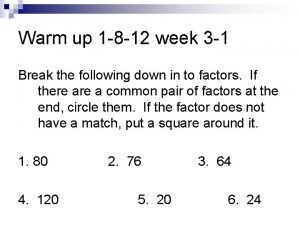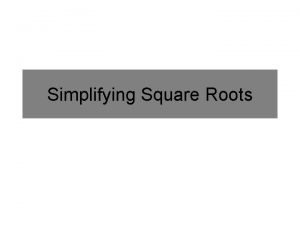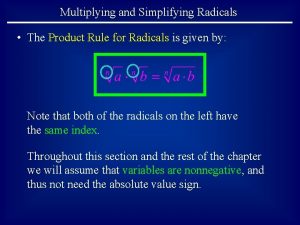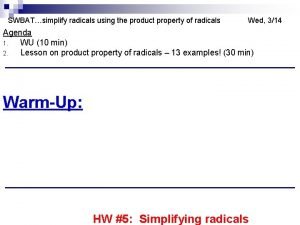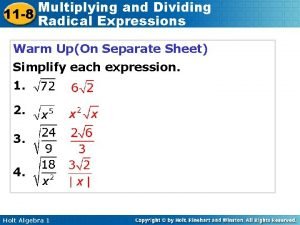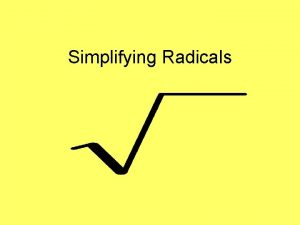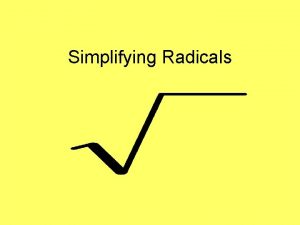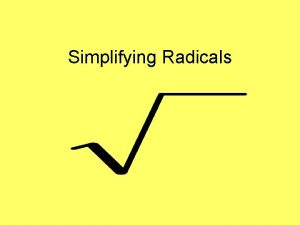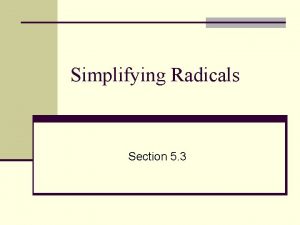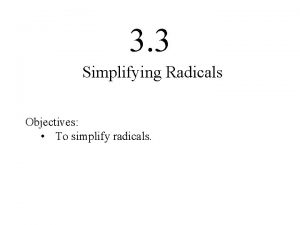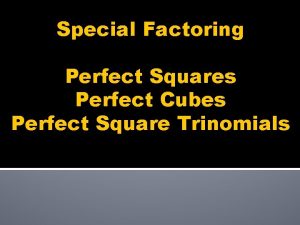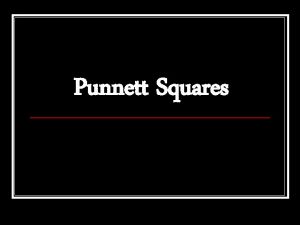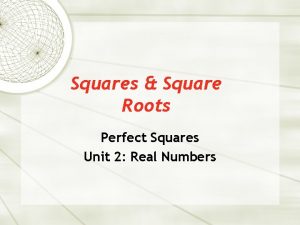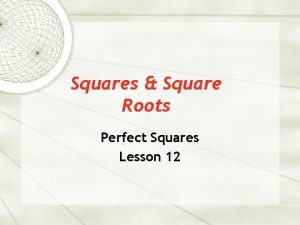Simplifying Radicals Perfect Squares 1 4 9 16























































- Slides: 55

Simplifying Radicals

Perfect Squares 1 4 9 16 25 36 49 64 225 81 100 121 144 169 196 256 289 324 400 625

How do you simplify variables in the radical? Look at these examples and try to find the pattern… What is the answer to ? As a general rule, divide the exponent by two. The remainder stays in the radical.

Simplifying variable radicands • X² • X • X


LEAVE IN RADICAL FORM Perfect Square Factor * Other Factor = = = = =

LEAVE IN RADICAL FORM Perfect Square Factor * Other Factor = = = = =

LEAVE IN RADICAL FORM Perfect Square Factor * Other Factor = = = = =

LEAVE IN RADICAL FORM Perfect Square Factor * Other Factor = = = = =

+ To combine radicals: combine the coefficients of like radicals

Simplify each expression

Simplify each expression

Simplify each expression: Simplify each radical first and then combine.

Simplify each expression: Simplify each radical first and then combine.

LEAVE IN RADICAL FORM Perfect Square Factor * Other Factor = = = = =

Simplify each expression

Simplify each expression

WORKSHEET 3)

5) 7)

9)

11)

13)

15)

17)



* To multiply radicals: multiply the coefficients and then multiply the radicands and then simplify the remaining radicals.

Multiply and then simplify


WORKSHEET(MULT)

WORKSHEET(MULT)

WORKSHEET(MULT)

WORKSHEET(MULT)

WORKSHEET(MULT)

WORKSHEET(MULT)

Using distributive Property • • a(b+c) = ab + ac a(b-c) = ab - ac

USING THE DISTRIBUTIVE PROPERTY

USING THE DISTRIBUTIVE PROPERTY

USING THE DISTRIBUTIVE PROPERTY

USING THE DISTRIBUTIVE PROPERTY

USING THE DISTRIBUTIVE PROPERTY

Using the FOIL

Using the FOIL

Using the FOIL

To divide radicals: divide the coefficients, divide the radicands if possible, and rationalize the denominator so that no radical remains in the denominator


This cannot be divided which leaves the radical in the denominator. We do not leave radicals in the denominator. So we need to rationalize by multiplying the fraction by something so we can eliminate the radical in the denominator. 42 cannot be simplified, so we are finished.

This can be divided which leaves the radical in the denominator. We do not leave radicals in the denominator. So we need to rationalize by multiplying the fraction by something so we can eliminate the radical in the denominator.

This cannot be divided which leaves the radical in the denominator. We do not leave radicals in the denominator. So we need to rationalize by multiplying the fraction by something so we can eliminate the radical in the denominator.

How do you simplify variables in the radical? Look at these examples and try to find the pattern… What is the answer to ? As a general rule, divide the exponent by two. The remainder stays in the radical.

How do you simplify variables in the radical? Look at these examples and try to find the pattern… As a general rule, divide the exponent by two.




 2744 cube root
2744 cube root How to multiply radicals with coefficients
How to multiply radicals with coefficients Examples of like radicals
Examples of like radicals What is an entire radical
What is an entire radical Simplifying radicals worksheet doc
Simplifying radicals worksheet doc Combine these radicals -6√100+√36
Combine these radicals -6√100+√36 18 1/4 in simplest radical form
18 1/4 in simplest radical form Unit 7-1 simplifying radicals
Unit 7-1 simplifying radicals Lesson 2 square roots
Lesson 2 square roots Multiply radical
Multiply radical Perfect square of 108
Perfect square of 108 Simplifying radical quiz
Simplifying radical quiz 11-3 solving radical equations
11-3 solving radical equations Simplifying radicals jeopardy
Simplifying radicals jeopardy Lesson 0-9 square roots and simplifying radicals answers
Lesson 0-9 square roots and simplifying radicals answers Simplifying radicals factor tree
Simplifying radicals factor tree Simplifying radicals homework
Simplifying radicals homework How many squares
How many squares My age
My age Past perfect present perfect future perfect
Past perfect present perfect future perfect Factoring the sum of squares
Factoring the sum of squares Square 1 to 25
Square 1 to 25 How to find perfect square
How to find perfect square Square root list
Square root list Greatest common factor of 60
Greatest common factor of 60 Perfect squares 1-1000
Perfect squares 1-1000 Square roots and cube roots guided notes
Square roots and cube roots guided notes How to determine a perfect square trinomial
How to determine a perfect square trinomial How to do pythagorean theorem with radicals
How to do pythagorean theorem with radicals All perfect squares
All perfect squares Perfect binomial
Perfect binomial What's a perfect square
What's a perfect square 2 squares a day
2 squares a day Simplify radical expression
Simplify radical expression Square root activity
Square root activity Square roots up to 30
Square roots up to 30 Adding integers examples
Adding integers examples Solving radical inequalities
Solving radical inequalities Factors of 126
Factors of 126 Quadratic formula round to the nearest hundredth calculator
Quadratic formula round to the nearest hundredth calculator How to solve radical equations and inequalities
How to solve radical equations and inequalities Parts of radical expression
Parts of radical expression Properties of radicals
Properties of radicals Quotient property of radicals
Quotient property of radicals Distance formula with radicals
Distance formula with radicals Complex numbers and rational exponents
Complex numbers and rational exponents How to simplify binomial radical expressions
How to simplify binomial radical expressions Properties of radicals
Properties of radicals Can you multiply radicals
Can you multiply radicals Like radicals examples
Like radicals examples Square root of a fraction
Square root of a fraction Product rule for radicals
Product rule for radicals Product property of radicals definition
Product property of radicals definition Radicals
Radicals Radical and rational equations
Radical and rational equations 10 multiply sums
10 multiply sums

